(version one - a snapshot of a young text)
|
Virgin Migrations (version one - a snapshot of a young text) |
|
Good book I try to call my parents every Sunday or Monday evening, a ritual I jokingly refer to as ancestor worship. Recently, during one of these calls, my dad told me he was reading a book about the history of the Bible. The book says that a long time ago when people translated the text of the Bible from one ancient language to another, there was a mistranslation regarding the mother of Jesus. In the earlier text, Mary was described with a word that, in English, means simply, young woman; in the newer text, she was described with a word that, in English, means virgin. 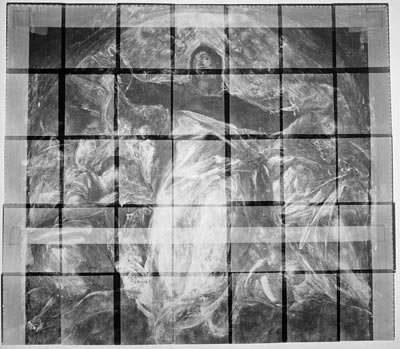 Religio I revere my older brother Andrew as my first intellectual mother. Reverence can have devastating consequences. ||||||||||||||||||||||| ||||||||||||||||| |||||||||||||||||| |||||||||||||||||||||| ||||||||||||||||||||||||||| |||||||||||||||||||||||||||||||||||| ||||||||||||||||| |||||||||| |||||||||||||||||||||||||||||||||||||| ||||||||||| |||||||||||||||||||||||||||||||||||||||||||| |||||||||||||||||||||||||| ||||||||||||||||||| ||||||||||||||||||||||| ||||||||||||. I have said to a number of people that through Andrew I was exposed to an intense passion for ideas that I sometimes think I wouldn't have been exposed to if not for the years of hours spent struggling with him. Andrew had a closet full of books and I snuck in there to revel in the deep fabric of text that seemed to have no beginning and no end. Somewhere in that fabric I found this: the word religion comes from the Latin root religio, literally translated as linking back; re meaning back, and ligio meaning linking. Now I generally think words don't so much get their meaning from their origins as they do from how, when, and where they are used. I mean, I don't know where a word comes from when I begin using it, I just use it because I need it and maybe later I will find out where it came from. But at least in this case I find the origin compelling--something I need. Of course, it's kind of obvious if you think about it, that the Latin word as it was used in ancient times also had it's own even more ancient origins. So, religio is a kind of snap-shot of a word on the move. Up and down the midwest I have only lived in Chicago for about 8 years. I moved here from St. Paul, Minnesota. My uncle, who now lives in Minnesota, South of St. Paul, used to live in Evanston, Illinois, north of where I now live now. I went to college in Indiana, Southeast of here, for a short time. I took my first art history class there. I loved it. It was like theology, divinity school. I didn't care to get Western history straight until I studied art history, which was mostly Western art history. One Spring semester in Indiana I had a car and at the end of the semester I drove back to Minnesota. I drove through Chicago on a hot, early summer day. I was just South of the loop, high on the Dan Ryan Expressway, over looking what I now know is Pilsen, at the moment a predominantly Mexican neighborhood. The Dan Ryan was completed in 1962. Before there was an expressway there were houses and buildings where people lived and worked and drank and did all the things we do in Chicago. I was sitting in stand-still traffic in this place where people used to do these things, breathing exhaust. It was then, in that claustrophobic moment, that I said to myself, out loud, "I am never going to live in Chicago." By the time I made it to the Kennedy Expressway a few miles North, traffic was moving along a little more quickly and I crossed over Fullerton Avenue not knowing that someday I would live no more than a mile from that place where, again, people once lived and worked and drank and where I was now passing at about 50 miles per hour, headed Northwest, getting the fuck out of Chicago. Better neighborhoods for pigeons East of where I live now, where the Kennedy passes over Ashland Avenue, between Bloomingdale and Armitage, I always want to hold my breath as I walk under the hulking structure of the overpass. There is the car exhaust, but what worries me more are the rich deposits of pigeon shit all over the place, particles of which must get kicked up by pedestrians and turbulent gusts of traffic. It must be a rich habitat for bacteria and fungus that could cause all kinds of illnesses, especially for people with compromised immune systems. And sometimes I suffer from a psychosomatically compromised immune system. Pigeons are not native to North America. Their ancient habitat is on the rocky cliffs of Europe and Southwest Asia. But they have as a relationship with humans as old as almost any animal--a long process of co-evolution. The built habitats of humans tend to make nice homes for pigeons, forming ledges and crannies similar to where their ancient ancestors would nest on cliffs. So, the range of pigeons spreads with concentrated human settlement and urban development. I imagine these pigeons as being pleased to discover some of the first such accommodations at the birth of Western Civilization--there between the Tigris and the Euphrates, in what we now call Iraq. Pigeons were first brought to North America, to what we now call Canada, by French colonizers in the 1600's. They brought pigeons as a source of food in a land where they didn't know how to live off of the native abundance. Colonizers often need to transform the landscape by deploying the familiar flora and fauna of their home--making it feel safer. This kind of biological incursion is a particularly gouging razor-edge on the destructive wedge of colonization. These French entrepreneurs hoped to monopolize the fur trade, moving up and down the St. Lawrence River, and eventually through the Great Lakes, establishing strong connections with the native populations, sharing technology and taking advantage of the native knowledge and labor in trapping and hunting the local critters for their pelts. Kikwessitore Marie, kipakoto nahitihakani kechihiwiya kiwitchiramekwoi, kirakichirame kimiyariwito, kiramauwaki mitemoseyani kamiya riwito, abosi wirakichirami kikwissa Jesossa eranta. Pekisita Marie, kechihiwaya akire, karotamauwinammi miyakotewinakosiange inonge, abosi ehe nipeyange karomauwinammi. Wendja matchi nichinakoki. --Hail Mary in Potowatomi Along with the traders came Missionaries. It was A Jesuit missionary, Jacques Marquette (whose patroness was the Virgin Mary), and a fur trader, Louis Joliet, that are commonly thought of as being the first European folks to come through what we now call Chicago. In 1673 they were guided by a teen-age Native American boy who was showing them a short-cut back to the Mission at Sault Ste. Marie, where they began. As missions were established and the French and Indian fur trade expanded around the Great Lakes region the pigeons must also have spread, happily nesting in the European style building of the traders and missionaries. The Missionaries, in their effort to convert the native population, translated the Bible into the local native languages including Potawatomi. Fur traders also learned the native languages and intermarried with the tribes. From early contact with the French until the early 1800's was a time of European and native cultural melding sometimes referred to as "The Middle Ground" by historians. While it was by no means a period devoid of destruction, or exploitation, and certainly not a time of peace, either between the Europeans and the Indians, between different Indian Nations, or between competing European fur traders, this early Midwestern colonial period marked cultural mingling and a mutually beneficial economy for Natives and Europeans that came to a somewhat abrupt end when in the 1800's Yankee barons brought a new much more destructive, rationalized, efficient, and racist form of development to the area. The newest newcomers were not forced to negotiate the sharing of resources and culture with the native population as the earlier colonizers had. The federal government's remapping of the land, in the Land Ordinance of 1785, as a gridded-out, empty space, mediated the barons' understanding and experience of the land; reducing it from its status as a place (statuses, really, since places can bear multiple meanings), to mere empty space. The barons saw a blank grid on which to compose grand plans to move hearts of other rich Yankee investors, hearts clad in stone, steal, glass, and concrete. They contributed to the development the balloon frame building (cheap 2x4 stud-frame construction), the skyscraper, the railroad, and the one of the earliest limited access highway systems (freeways). In so doing they unwittingly laid the foundations for more pigeon habitat than the planet had ever seen. The French and their pigeons weren't the first people to move up the St. Lawrence River to establish a presence in the Western Great Lakes Region and the area of Chicago. Many different indigenous peoples used moved through the place we call Chicago: Miamis, Sacs, Illinois, to name a few. However, there was very little permanent settlement in the area, and it is often described as a perennial crossroads. Which makes sense, since it was mostly a swamp. Permanent settlement in the area didn't occur until the fur trade established the mouth of the Chicago River as an economically strategic location. Though not the only culture to establish a sustained settlement in the area, the Potawatomi had the most recent and longest settlement before Indian removal and Yankee domination. The Potawatomi oral tradition also describes their migration as coming from the Northeast. They were part of a brotherhood of three tribes, with the Ottawa and Ojibwa, whose origin is described as being in the area of the St. Lawrence River. They migrated south and west, it is suspected, as the North American climate changed in the 1400's; they continued to move and migrate due to conflict with other tribes and in search of a place where the land and the people lead a sustained co-existence. How exotic am I? I remember thinking for many years how unfathomable it was to me that the Mayas and Aztecs of ancient Mexico actually sacrificed peoples' lives in ceremonies. Now, to the extent that this reflects any reality, I have my suspicions that this practice is at least as reasonable if not more reasonable than some comparable practices in our own culture. As far as human sacrifice goes, what do you call 50,000 traffic deaths a year? To me that is human sacrifice in the name of speed and privacy and convenience (but not really that much convenience). At least the Aztecs and Mayas made their sacrifices ceremoniously and with honor. In our culture human sacrifice is obscured behind the oxy-moronic rhetoric of auto-safety, while running out for kitty litter and dental floss. Not to mention the human sacrifice for the oil that makes those cars go. "One major difficulty which non-Indians face in trying to make an imprint on the North American continent is the absence of any real or lasting communities. Non-Indian Americans, not the Indians are the real nomads." --Vine Deloria Jr. Mourning after Thanksgiving Many people feel that the U.S. holiday called Thanksgiving should be a National Day of Mourning to recognize the genocidal crimes against Native Americans. Seems like a good idea to me. None-the-less, for many years my family used it as an occasion to visit my uncle in Chicago, eat food, go shopping, take in a bit of what the city had to offer. Boring. After my first term at college in Indiana I met the rest of my family in Evanston for Thanksgiving. On the day that many people now call "Buy Nothing Day", the day after Thanksgiving, our family visited the Art Institute of Chicago. In the early 1900's an artist born in the United States, Mary Cassat, lived and worked in France. But she had social connections with the director of the Art Institute. She was instrumental in the acquisition of their famous painting "Assumption of the Virgin", made by Domenico TheotokŘpoulos. Usually known as El Greco, TheotokŘpoulos, was born in Greece but lived and worked in Spain in the 1500's. This painting was reproduced in my first art history text book, the one I studied in Indiana. Cassatt knew the Church in Toledo, Spain that had commissioned El Greco to make the painting, was looking to raise money by selling the painting. For hundreds of years it was part of the church's altar, now a reproduction stands in its place. Cassatt and many people of her time felt it was important for students at the Art Institute to be able to study works of European masters, like El Greco, in their own city. Of course I didn't know any of this at the time but when I sat in front of the giant painting on that Buy Nothing Day, what started as a feeling of gratification that I was able to name the painting and artist without reading the label, quickly became an overwhelming feeling of grief and confusion, and seeing that blade-like crescent moon there under her feet, I began to cry right there in the gallery. I think I was thinking about home. I was more displaced than I had ever been, but there was some solace in this picture. Since that time, about 12 years ago, I have received an undergraduate degree from the Art Institute and held a day job in the museum for about 6 years. My alma mater, as my mom says. I have always felt the bronze lions in front of the museum should have been female. 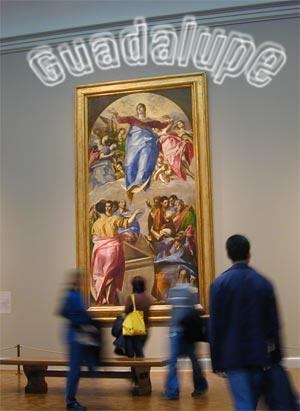 El Greco's Assumption of the Virgin at the Art Institute of Chicago. "I don't know if it was the fact that I haven't talked to S in days (he's out on missions every night, finding weapons caches, other things) our unfulfilled desire to have kids, the wonderful play I saw last night ("Living Out" from Teatro Vista) about a Salvadoran nanny and the loss of her sons, or a combination of all these mixed together with the pain and sorrow around me. Whatever it was, tears came while I stood in the crowd under the freeway." --Kate Ingold, April 24, 2005 In the year 1531, during the early colonial period in Central America, there was a Nahuatl Indian in Tenochtitlan, now called Mexico. He was near what most white people in the U.S . call Mexico City. There is speculation that this Indian, named Cuauhtlatŕhuac, was a spiritual leader of some kind until Spanish missionaries gained influence over the area, when he converted to Catholicism and took the name Juan Diego. He was on his way to visit a sick family member when he was crossing over a place, a hill that had a history as the shrine of a Nahuatl goddess. On this place he was visited by a holy vision, a goddess instructing him that a temple be built in that place. Before the Spanish presence in this place the Aztecs were in power. Of course, it's kind of obvious if you think about it, that before there were Aztecs this hill still would have been there, and it makes sense that there was some reason why people saw this place as having a spiritual significance. It's a matter of perception and consciousness; there must have been stories about this place that would be passed down in time, and as soon as the patriarchs of the Aztec empire came to power they told the story their way. And in turn, the Catholic authorities would take control of it, as much as they could, after Juan Diego told them of his encounter on the hill, and tell the story their way. Since it's a matter of preoccupation and habit, the Catholic authorities mistranslated the news delivered by Juan Diego. It is not known exactly how he described the visitation he experienced there on the hill, but they understood that the goddess was the Virgin of Guadalupe, a Virgin indigenous to a town back in Spain, whose name closely resembled, in sound, the more indigenous goddess that it is likely Juan Diego was telling them about. Ana Castillo suggests that he may have been saying the Nahuatl words Tlecuahtlacupeuh, she who comes flying from the light like an eagle of fire; or Coatlaxopeuh, she who crushed the serpent's head. Bohemian migrations The Virgin of Guadalupe is ubiquitous in Chicago; certainly anywhere Mexican immigrants live you will find her. But also, she is commonly fetishised by people like me, from white, middle-class backgrounds. We come to Chicago to become artists, musicians, hipsters, transplanted from the suburbs or smaller urban centers around the Midwest, seeking out cheap apartments. This search often brings us to neighborhoods with large immigrant populations. It is often the first time in our lives we have any significant contact with people of a different socio-economic background. In neighborhoods like Pilsen we see the image of the Virgin of Guadalupe all over the place and in an effort to understand her and make meaning of her we are compelled to collect our own images of her. I have been in many of the apartments of people like me and seen many near shrines to her, arranged almost subconsciously, by agnostics, protestants, atheists, Jews, and people who don't think about religion at all. Both of these transplanted peoples, the suburban/transurban hipsters and Latino immigrants, need affordable housing, even if generally, people like me come from a world of greater privilege. The presence of people like me in these neighborhoods where affordable housing can be found, as the story goes--and there is a lot of truth in this very simplistic story--changes the way the neighborhood looks and feels. Our presence makes the neighborhood feel safer for developers and other middleclass people--less adventurous people, less the victims of modern bohemian fantasy„also from the suburbs. They are looking for bargains, wishing to become property owners. living a more marginalized version of the American dream, the hipsters won't think of buying for a few more years. It is the local manifestation of a global phenomenon called gentrification, the destruction of low-cost housing. (To many, hearing this story retold here is quite tiresome. Well, some people haven't heard it enough, and frankly, I think the exhaustion is not with the story but an exhaustion born of guilt. So the question is, how can I deal with that?) For a short time, before development comes in, before the condos get built, there is a fleeting moment when two convergent populations are having a mutual need for affordable housing fulfilled. In these early stages of gentrification, the young and curious hipster-types appreciate the ubiquity of La Virgen and attempt to ascertain her meaning. But this appreciation seems to stop short, somewhere around the status of kitsch, she just becomes another action-figure-bookend. This is a truncated, diluted appreciation. I think this interest in La Virgen is a thread that if followed reveals itself as part of larger fabric more profound than the need for kitsch. In a city with deep social divides people of my class and cultural background are like everybody else, they are most at ease spending time with people like themselves. We are often not socially sophisticated and are the passive victims of assumptions perpetuated by dominant socializing forces„the media and other educational institutions--that tell us navigating those deep divides demands a set of elusive and specialized social skills. In the end we fail to have sustained relationships with people outside of our own class and cultural backgrounds. The token identification through the idol of La Virgen is the marker of a deep unfulfilled desire for a more substantial relationships with the people we live near; it is an idle identification. "Images of humans (even spontaneous ones) and their role in spirituality have presented problems in the past because people ultimately depend on them and their ephemeral natures, thus impairing the more rewarding and durable qualities hidden within us all." --Ibrahim N. Abusharif Local diva In the Spring of 2005, Obdulia Delgado discovered an apparition of La Virgen De Guadalupe on an a wall beneath the outbound, or west-bound lane, of the Kennedy Expressway at Fullerton Avenue. This apparition became known as the La Virgen Del Puente, or, the Virgin of the Underpass. There are many accounts of people like me visiting this site that can be found in the blogo-sphere, reposting the story from some other news sources, cel-phone pictures of the crowds, and some fairly thoughtless opinion, calling devotees idiots is perhaps the most common opinion. The murmuring din of blog offerings mostly just reflects the din of the freeway above this apparition; it is an important flow, the daily commute, but it hardly gets more mundane, traumatically mundane, than driving to work. Been there, done that. No thanks. On a Tuesday, months after Delgado's discovery, after the crowds had cleared from beneath the underpass, I called in sick to my job. I can always be sick. Besides, I had work to do. I had a walk I needed to go on and drawings to make. It was a good day to get a sunburn and I had tacitly been wanting to visit La Virgen Del Puente since I saw the fleeting images on those unforgivably stupid local newscasts. I came at the place from the Southwest. I could see where she was, the shrine, but had to skirt the site--not able to come too close until I had established a workable rapport with the location. Trepidation and mistrust, certainly in this case, are the flipside of the same coin as reverence. I traced a gradual spiral as I skirted. First scrutinizing the Southern underpass wall, opposite the apparition, thinking that there must be dozens of deities in the clouds of pollution on these walls; wolves and coyotes, christs and buddhas, hares and dragons. It's a matter of perception and consciousness, preoccupation and habit, which I guess is why nothing seemed to come together for me. My arc took me across the treacherous lanes of traffic. I took note of the nearby billboard, a picture of a cartoon lion; the embankments along the expressway covered in thirsty plants I wished I could name. I came to a resting pointing, the center of the spiral, a good, safe thirty feet out in front of La Virgen, a curb to sit on. There were three police barriers around the shrine, just in case I got any ideas. I sat and looked, took in t he sounds and smells the place. The shade of the underpass was welcome and it channeled the day's muggy breeze into a cooling wind. But all there was to breath was exhaust and all there was to hear was the din of the expressway overhead--a hard place all around--a place that expresses no sensitivity to self-propelled human bodies. But for the human-sized Virgen and her shrine, you would think that this is a place that hates pedestrians. There I sat making notes and drawings, waiting for something to happen. And things started to happen. It occurred to me that the blue police barriers were kind of like the Virgin's mantle, this protective shield the color of a faded and scratched-up night sky. These barriers are endowed with a kind of supernatural power...like any good mantle...then again, in this case it the power of legal authority, which is really extra-natural power, not supernatural power. But more happened; people came to visit. A Latino family, two women in their 30's, maybe sisters, with a gaggle of little ones. One of the women, with the littlest child in her arms, knelt down a good 15 feet away and approached the apparition on her knees, passing right through the set of police barriers. I was so moved by this act of devotion I burst into tears, not really understanding myself, not really knowing where I was, but being quite sure that this flow was necessary. If nothing else, it would punctuate my memory of this foray. 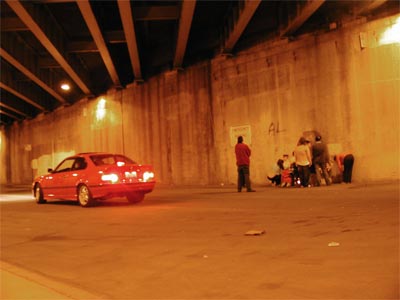 January, 2006 under the Kennedy Expressway at Fullerton Avenue, the site of La Virgen Del Puente. After Surreptitiously snapping this picture a woman from this group offered me change. I refused, which felt rude. (How quickly does the salt I consume become a part of my tears? Was I tasting the same salt that I had in my oatmeal that morning? ) "Myths are the stories that explain a people's beliefs about their purpose for living and their reason for dying. The stories are often told through allegory and parable to facilitate a cultural understanding of what is by nature perhaps too complex for the general populace to grasp. The Mexican indigenous account of the Mother Goddess is rich in Nahua symbolism and meaning." --Ana Castillo p. xviii Goddess of the Americas I took exception to this when I first read it, thinking it sells the intellectual capacity of the "general populace" short. But the more I think I about it the more the more complex it gets for me and the more it seems to reflect some of my own experience, being part of the general populace, I guess. I still don't know exactly what to think of the emotional experiences I had in the presence to these two local apparitions of the Virgin Mary„under the Kennedy and at the Art Institute--but I have decided that they are religious experiences and that I must be a devotee of this deity. As the image of Guadalupe became a vessel to grasp the devastating changes brought on by the early colonial period in Mexico, these local manifestations have become a very personal vessel helping me to grasp some of my own grief. This grief may be an emotional experience that has been too complex or profound for me to begin to accept without first feeling the fabric of the mantle of Guadalupe folding around me. Delmar means "of the sea" in Spanish Some things that my brother has said have stuck with me for years, even though I didn't understand them. My brother is often unwilling to explain himself or his utterances, so to some extent I am habituated not to ask him what he means. Andrew and I both take a lot of pleasure in vegetative image consumption of the small and large screens. During the most difficult years, before I had to leave for Chicago because it got too difficult, one place we could usually find peace with each other and the world was in watching movies together. We particularly enjoyed the movies of two other Minnesota-born brothers, Joel and Ethan Coen. One thing that Andrew said years ago, that has stuck with me, has to do with the Coen Brothers' movie, "O Brother, Where Art Thou?" He told me about his preoccupation with a line delivered by the character of Delmar O'Donnel, played in this movie by Tim Blake Nelson. It goes like this: George Cloony plays the charming protagonist of the movie, who has just been jilted by his ex-wife. He is on a furious, misogynistic rant, when he interrupts himself to ask his side-kick Delmar if he has, "ever been with a woman?" Delmar responds, "Well, uh, I - I gotta get the family farm back before I can start thinkin' about that." The implication here is that Delmar has never had sex, and that this desire is deferred until he can get the family farm back. Sex and home are bound to one another for him. I am not sure what this is about for Andrew, but I there must be some reason that the line has stuck with me for years--after Andrew made a point of sticking it to me. All I can think is that must be related to my dissatisfaction with our culture's conception of home. Delmar longs to get the farm back, and won't be satisfied until he gets it. I won't be satisfied either; I have some questions about home and so far I have refused to be satisfied by the answers our culture has to offer. Delmar knows what he longs for. I feel a longing that I have a hard time describing. Anguished dirt Rosario Castellanos says that "sexuality is a dynamic force that is projected outwards and is manifested in deeds." I've also heard this: sexuality is nothing less than how you touch the world and how the world touches you back. Any deeds? Any touching? There is an image I behold, that I found in a book somewhere (I think it was a Vine Deloria Jr. book) but I can't seem to find it again. It is an image of soil that loves. It came back to me on a recent very anguished walk along the margins of the Kennedy Expressway. I thought of the time I hurt my knee a few months before I moved to Chicago. My parents took me to the hospital. I realized retrospectively how happy I was to be carried by them again. I was stricken by the dirt under the over passes. It takes on this eerie dusty texture, half pigeon shit and half car exhaust, just looking at it makes me want to wash my hands. Then I thought of the image from this Vine Deloria Jr. book, of soil that would cradle my feet as I walked; soil that knew me and was conscious of me; a place that expressed caring sensitivity to my presence. But since it is about perception and habit; since it is about how I touch the world, not just how the world touches me back, wouldn't I need to develop a some sensitivity to the soil to have this experience? Of course one could never have a relationship like this with all places. Most places are indifferent, or too hostile, but it doesn't seem outlandish that there might be someplace like this. This image relates to that longing I can't describe. Maybe it's very small though, like how I couldn't have described my longing to be carried by my parents. Wolves on the farm One of my great grandfathers moved from central Illinois to Southern Minnesota where he bought a hunk of farmland. This fall my Dad and Uncle plan to auction off the last 40 acres off that land off, unless I can figure out a way to convince them to hold onto it. I love my dad and my uncle but it hurts me that they only seem to see this land as an investment, a source of income. I also understand that the way they see the land reflects the way our government sees the land. All of this merely serves industrial agriculture that dominates and is destroying the very last vestiges of human activity the rural United States, not to mention the fragile remaining fragments of prairie that used to roll through it. 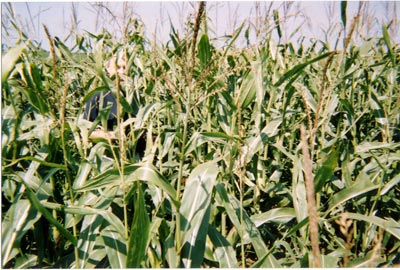 Dad in the corn, down on the farm. Beneath this sky another sky Somewhere I heard that before Michel Angelo was commissioned to cover it with his frescos the ceiling of the Sistine Chapel was painted to look like the night sky. My first job in Chicago was at the Music Box Theater, an independently owned movie theater that shows art movies. I worked there for almost three years while I was finishing my undergraduate degree, selling pop corn, making friends and enemies with other concessionaires, watching and falling in love with movies, and eventually becoming a projectionist. It's my other alma mater. I met Dan Gleason there, who is one of the only people in the world--outside of my family--that has helped me to understand the meaning of unconditional love. The ceiling in the big theater at the Music Box is painted to look like the night sky and the stars light up. I felt very privileged, for some reason, when I was offered the job of replacing the burnt out bulbs in the ceiling. I came in on a Tuesday morning and spent a few hours covered in old dust and grease, crawling around above the sky, replacing the stars. 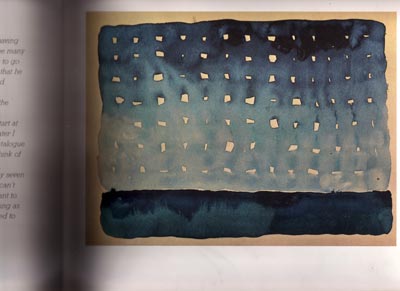 O'Keeffe's Starlight Night Georgia O'Keeffe attended the School of the Art Institute of Chicago for a short time, a Summer maybe. She hated it--too conservative (not much has changed). None-the-less, when I first began considering attending the Art Institute, in the promotional materials they sent me, her name appeared on a list of famous people that had attended the school. I was exposed to O'Keeffe early; she was a household name in our house. My mom, a fan, hung a reproduction of one of her paintings (I don't remember which) on the wall I faced while seated on the toilet. It went well with the floor. I think the fact that O'Keeffe attended the Art Institute reinforced the clarity of my decision to transfer there from the liberal arts college in Indiana. Even though they seem disingenuous to me now, the promotional materials worked on me. 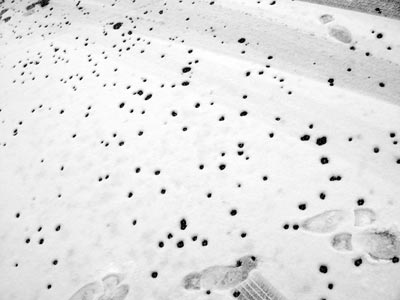 Road salt in fresh snow on Milwaukee Avenue, 2006. Right before it snows it pours Road salt has very destructive effects on vegetation where ever it is used, and Chicago spreads well over 100,000 tons of salt on roads every year. It seeps into the ground water destroying the fragile and rare ecosystems of Chicago area wetlands and becomes airborne, a cloud of salt, coating and killing all nearby vegetation, encouraging the growth of non-native vegetation that can tolerate high salt levels. In 2000 I had my first "solo show" in a gallery, an apartment gallery, in Pilsen, a place called Dogmatic. A guy named Michael Thomas runs Dogmatic, though when it first opened there were 4 guys that ran it together. Michael is an artist too, and in his bedroom, in the same building that Dogmatic started in, hangs a painting he made depicting an impregnated Morton Salt "Umbrella Girl". I don't know what this painting is about, but it has always been strikingly perverse idea to me, and for that, I like it. It was when Michael and I were planning for my show that I first talked about this painting with him. In the course of the conversation Michael told me that he was fairly certain that Georgia O'Keeffe, during her time in Chicago, did some work as a graphic artist and actually designed the "Umbrella Girl" logo. Oddly, at the time I would not have spoken with anybody about O'Keeffe, how important she is to me, thinking her a very unpopular art historical figure among my contemporaries. It was liberating to know that she was also very important to Michael and that the fact that she attended the Art Institute for a short time also affected Michael's decision to move to Chicago, from Michigan. 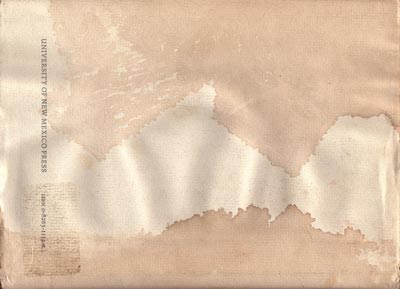 Michael Thomas's book. Michael lent me a book, now out of print, of some of O'Keeffe's early works on paper. I brought the book with me for light reading on a trip to Minnesota. Traveling outbound on the Kennedy Expressway the book sat at my feet in the passenger seat, my dad was driving, and Dan Gleason in the back seat. I finished my coffee and put the cup on the floor where it rolled around, leaking dregs, and ruining the book Michael lent me. Thoughtless. I felt terrible when I discovered what I had done and I stupidly avoided Michael for nearly a year as a result. But this is not the kind of thing that can ruin a friendship between two guys who have confided in each other their mutual admiration for Georgia O'Keeffe. It turns out Michael was wrong, O'Keeffe did not design the Morton Girl, but the Little Dutch Girl. I don't even know who she is or what product she is hocking. On Elston Avenue, less then a mile Southeast of the site of La Virgen Del Puente, is a Morton Salt distribution facility. The facility has direct access to the three major transportation arteries that have helped Chicago maintain its status as a behemoth capitalist hub throughout its history: The Kennedy Expressway, Chicago & North Western Railway, and the Chicago River. It is via the river that this facility still receives salt barges from Louisiana. There is no doubt that much of this salt ends up on Chicago streets in the Winter, and the Kennedy Expressway. And it is likely that it is this very salt that formed the apparition of La Virgen Del Puente, there, under the expressway. "Salt has been used to improve traction since the 1930s. But it was the construction of the interstate highway system in the 1950s and 1960s, and the concurrent boom in car ownership, that dramatically swelled the use of deicing salts. One of the regional sites where its effects became most apparent was the Morton Arboretum in Lisle, which was founded in 1922 by Joy Morton, who, ironically, made his fortune with the Morton Salt Company and was the son of the founder of Arbor Day. Morton Salt has sold road salt for most of its existence and still sells a lot today." --Peter Friederici Towering versus flowing The story of La Virgen Del Puente broke in late April, 2005. Presumably the image began to form in the months leading up to this time. It is an image formed by flowing fluids, water, oil, grime, antifreeze, from the surface of the expressway. These fluids carry the minerals, road salt, and other pollutants down through the fill under the surface of the road and flow toward the crack in the wall around which the image of La Virgen appears, as the minerals and pollutants crystallize and cake together. I have this fantasy that part of the image might be formed by Oprah's discarded coffee. Imagine that she is stuck in traffic on the expressway headed out to her private jet at O'Hare. Pissed off, her coffee is cold, she pours it out the window of her limo, it splashes, settles, and pulls itself down into the microscopic fissures in the surface. How long does it take for that coffee to flow down through the ruble and remains of the former neighborhood, to the crack in the wall? Our contemporary diva gives the ancient goddess, La Virgen, a little pigment. There has been some speculation as to why she appeared at this moment in particular. To my mind this is a question of why these fluids began to emanate from the wall. She is a goddess of emanation, of tears and blood, love and labor, death and birth, and of course milk and seminal fluids. Some people have said that she came because of the death of the pope. I don't buy that. That's not why she came to me. Here is what I think, this site, under the expressway was always an emanant domain, a place of flowing life, and that it was subsumed by modern capital's eminent domain, the power of the state to take property for economic gain. It was a place where a building once stood, where people worked and lived and drank until a plan came down from the top and the living activities in this place were put to a stop. Their building was taken from them and burned and it was covered with a freeway. It happens that in the months leading up to this apparition, the case of Kelo v. New London was being argued in the Supreme Court, and on June 23, 2005, the case was decided against the people. The Supreme Court found that it was constitutional for the state of Connecticut to invoke the power of eminent domain, removing people their homes in the name of private economic development. Yes, the court thought it was okay to destroy people's homes to build an office park. I think this case affected the flows under the expressway, that it reopened old wounds and that she came to console the people for the destructive, unjust, and undemocratic actions of our government. And maybe to help inspire a response. (I heard several times that the Spring of 2005 was one of the driest on record in Chicago. It seems a little mysterious that an apparition depending on water, rain, would come about in such dry conditions.) Beneath this economy another economy But economy, like religion, also changes. It wasn't always this way; economy used to mean something else. When my dear friend Brian and I are out together, exploring the night, shimmying along the frayed fantasies of modern bohemian romance, the phones in our pockets come into play from time to time, a markedly unpleasing vibration. We look at each other. We both know that it wasn't like this a couple of years ago and we ask each other, because it's the least we can do, "what have we become?" and more importantly," can we live with this?" Can we? Can we live with this economy, is this our religion? What were we before? Economy was about the management of the household; it was a word to be used in describing the way home is conceived, the way the needs of the people in that home are dealt with. How will we get fed? Who will wipe baby's ass? When and where can we fuck? How will we keep warm this Winter? We live in a world where the dominant economy answers these questions very brutally: Some baby's asses do not get wiped, some people will freeze to death this Winter, some people don't get to fuck, some people will not get fed, because they cannot afford it, and some people will be forced out of their homes because they cannot afford to stay. How does this sit with our sense of survival? What have we become? Art plays deeply into my sense of survival. I think of it, at least in part, as being an effort to construct my own cosmos, to be an active agent in the making of how the world is understood. Yet my understanding is authored by many, each utterance of mine is a remaking of something I have been given or have stolen from somewhere, everything that comes out of my mouth, each step I take, each light bulb I replace, is a collective act of making out the world. Accounting for all that I have been given by acknowledgment is an impossible task and the idea of repayment or compensation is a laughable fiction. But at least, maybe when I am gone they will be good enough to compost me, so the dirt can take my body as repayment. Anyway I want to make a snapshot of some nearby portion of my night sky, that is visible to me now at the making of Virgin Migrations, as captured with the humble fidelity of, say, a grateful phone camera: Mom, dad and grandma are an economic bedrock, the moon, there was no world without them. I owe a debt of gratitude to the following, some of whom directly contributed to the making of this and couple who just must be mentioned, shimmering planets: Andrew Wolf (complex poet), Dan Gleason (joyous shitter), Brian Taylor (heaver drinker of the vital nectars), Mary Walling Blackburn (brutally kind, the least of what she did was to give me editorial help, a big space to make this big stuff, and many good ideas), Dr. Jo-Ann Finkelstein (well paid, psychic co-cartographer), Karin Patzke (and big blue, and tank), Mess Hall (MH'ers, past and present, clean up your act), Bonnie Fortune (social quilter), coworkers in the Art Institute AV Department (taking up my slack while I wrote this, or had a hangover), Annie Morse (artist's advocate if ever there was one). What is this made of? What kind of fabric is this? How will it last? Here is an incomplete list of people whose ideas I ripped unabashedly, whether they would recognize it our not: Laurie Palmer, Temporary Services, Critical Art Ensemble, Sigmar Polke, Gregg Bordowitz, V for Vendetta (the greatest math rock band ever, not the comic/movie), Genevieve Vaughn... And of course these are some of the books and web pages I used (textual threads to pick up): Tinkering with Eden: A Natural History of Exotic Species in America, by Kim Todd, 2001. Goddess of the Americas: Writings on the Virgin of Guadalupe, edited by Ana Castillo, 1996. God is Red: A Native View of Religion, by Vine Deloria, Jr., 1994. For This Land: Writings on Religion in America, Vine Deloria, Jr., 1999. City of the Century: The Epic of Chicago and The Making of America, Donald L. Miller, 1996. Broken Windows, Kate Ingold's blog. Chicago Wilderness Magazine, http://www.chicagowildernessmag.org/issues/winter2004/salt.html. Alt.muslim, http://altmuslim.com/perm.php?id=1439_0_25_0_C. Encyclopedia Chicago. Native-Languages.org. Dickshovel.com, http://dickshovel.com/pota.html... Diagonal streets, from stitch A to stitch B I walk to work when I manage to wake up in time, from Humboldt Park to the Art Institute. It takes about an hour and a half. I am disturbed if I can't walk. I am tired of the neglected public transportation system. I don't have a car and don't like to drive anyway. I had to stop commuting on my bike, out of fear for my life and limbs. I am not the only person I know who finds biking in this city to be a frightening way to travel. Daley's efforts to make the city bike-friendly are token efforts at best, and a severe waste of money and resources at worst. There needs to be a serious reinvestment in public transportation and cars must be kept out of the city center where ever possible. I think Milwaukee Avenue should be made into a bicycle and pedestrian corridor. Yeah, with no cars. I walk to work on Milwaukee. My morning commute brings me to a point, Wolf Point, where the North and South branches of the Chicago River meet. The water always seems a little ambivalent about which direction it wants to flow, confused. My uncle, the one who used to live on Chicago's North side, but now lives in Southern Minnesota, loves things that share our surname. For a while when I was a kid he always seemed to be finding and giving me things with our name on it. There was a baseball hat with a cartoon wolf drinking a can of Coors and the words "Beer Wolf." I didn't like beer at the time, but since then I have become somewhat of a beer wolf, even if I avoid Coors whenever possible. He also gave me a case of canned chili fro m Texas, Wolf Brand Chili, a few years later I spent two very miserable, confused months, ambivalent about which way to flow, in Texas. I saw this Chili on the shelves of the grocery stores there. I don't think it brought me any comfort. With the chili came a Wolf Brand keychain that I used for most of my high school career. It hung from the ignition key as I drove the morning commute to school, out of St. Paul, past Mounds Park, toward Chicago on I-94, but just to the suburbs, Maplewood. Also, there seemed to be an endless supply of Wolf Brand baseball hats flowing out of the closets of our house. I wore them skateboarding, in the late 80's, before they were called trucker hats. 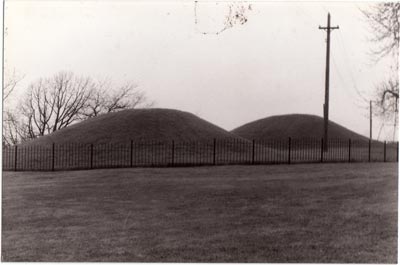 Mounds Park, St. Paul, Minnesota. The telephone pole has been removed since I took this picture. When I found out about Wolf Point in Chicago I immediately wondered if my uncle was aware of this place--its name--and thought it would be a fitting place for he and I to meet. Historically it was a place of meeting, for Indians, fur traders, settlers, and later, as the development of the Midwest really started to pick up, after Indian removal Act was passed by Andrew Jackson in 1830, and The Grand Settlement in 1833, Wolf Point quickly became a place for Yankees to slum, and get away from the wives for some good old-fashioned man on man action. The river waters still reflect those mingling flows of the earliest days of Chicago's capitalist period, when Wolf Point was a place for trading, socializing, drinking, gambling, and of course, whoring. 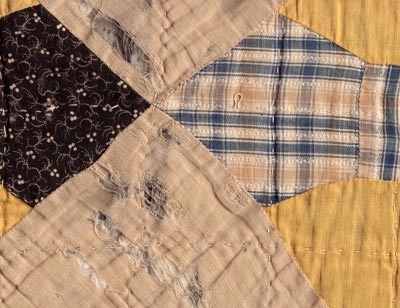 Part of a quilt made by my great grandma, Frieda Marie Wolf. The word "point" is used now to refer to a punctuation mark--a little dot, that you find in bank statements, in web addresses, or at the end of sentences, like this. But in French it can also mean "stitch." Since so many of the folks that occupied and partied at Wolf Point during the settlement of the area were French--or were fucking French people, or in turn were half French and half Indian--it makes some sense to think of the place as a stitch on the fabric of the city's landscape. Looking at a point on a map as a stitch must change the way we think about what is being represented. Wolf Stitch, a place where Milwaukee Avenue should end at the shore of the river, where Daley might like to have his name on the bottom of another bronze plaque (lest we forget), presenting a facade of the history of the colonization of this hot corner of the Midwest. The railroad runs along the river blocking any safe or legal access to the drop off into the water (it used to be a shore). Nearby condos are under construction. They occupy large plots of land I wish were public. They are too expensive for most Chicagoans. There is no ambivalence that the intention with these buildings is to flow all the way to the bank. Misanthropic as it might be, I relish the prospect of their financial and structural failure. I prefer the honest confusion of the river. There is a triangular lot squeezed between the buildings and the train tracks, as with any open space anywhere near downtown Chicago it is used for the parking of cars, and parks usually seem to double as parking lots since capital demands that space produces revenue. Places are reduced to space, robbing them of their aesthetic quality. I think I might like a deep, deep void„the void of the unaccounted for--carved out of this place, too deep and dark to see the shit that must be accumulating at the bottom, perversely empty. Right next to the river--with shit accumulating on the surface--it would fill the chasm up in a minute if not for the thoughtful engineering that would have to go into this kind of radical transformation of place. Around this great void would be a railing, at the right height for me to crawl up to it and hang my head over the edge and do whatever one does when one hangs his head, or bows it. Mike Wolf, 2006 Network of Cumulative Art This publication is for my loved ones, the people who helped make it, and the people whose loving texts I have used in making it. The rest of you are just along for the ride. And I am grateful you are here. If you have questions or would like to talk about it drop me a line. web: www.stopgostop.com/nca email: mistywoof(at)gmail.com |